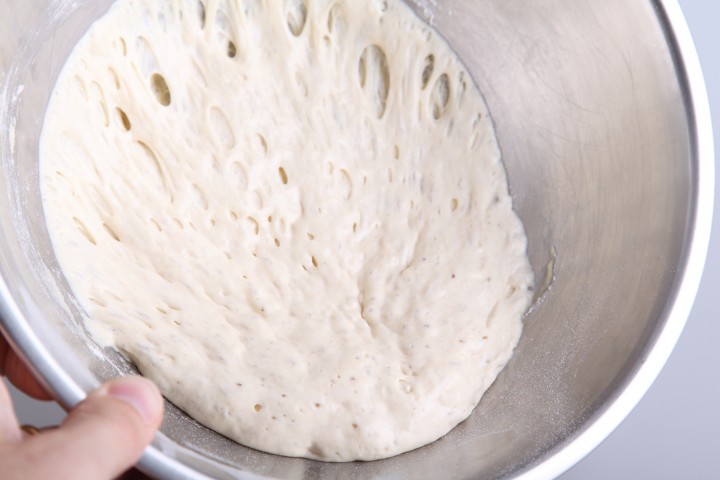
What is it?
There are several traditional methods for creating starters for breads. All of these starters are easy to prepare.
A starter usually consists of a simple mixture of wheat flour, water, and a leavening agent (typically yeast or a sourdough culture). After mixing it is allowed to ferment for a period of time, and then is added to bread dough as a substitute for, or in addition to more yeast. So pre-ferments are critical for best tasting bread – You can call it a starter, biga, poolish, preferment, or sponge – they all do sort of the same job and only really differ by water content.
Biga and poolish are terms for pre-ferments used in Italian and French baking, respectively, for sponges made with domestic baker’s yeast. Poolish is a fairly wet sponge (typically made with a one-part-flour-to-one-part-water ratio by weight), while biga is usually drier. Bigas can be held longer at their peak than wetter sponges, while a poolish is one known technique to increase a dough’s extensibility.
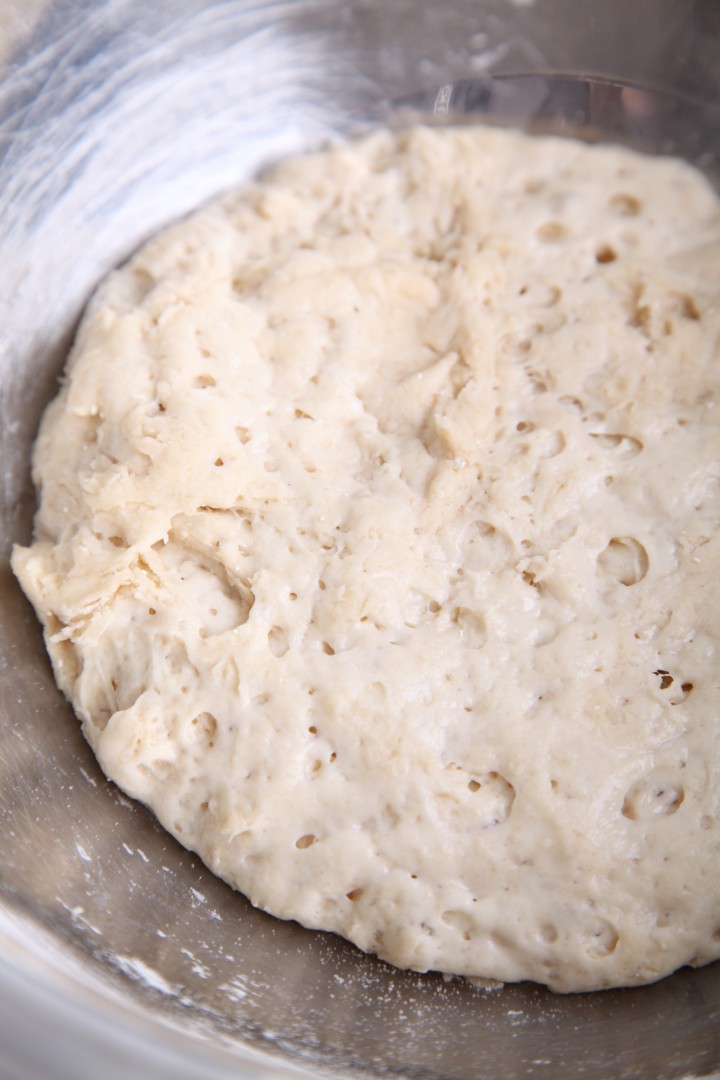
Why use it?
The primary difference between making bread with a starter and making bread with the direct or straight yeast method is that starter breads require much more time to prepare, but the flavor and texture of the bread is almost impossible to achieve with other leavening methods. Bread made with starters like poolish and biga also tends to keep better, compared to bread made from straight doughs.
Poolish & biga tips
- If you are working with pre-fermented doughs like poolish or biga make sure not to ‘over ripe’ your pre-ferment. This is especially true when using larger percentages of preferment in your final dough (think up to 50%) because over riping will kill the gluten in your preferment (the yeast will eat them all) and you will end up with a weaker and hard to handle dough.
- The higher the percentage of pre-ferment you use the more your bread crumb will have a nice chewy texture (but it stops at around 50%). We like our bread that way, it gives you something to chew on. The sugars that are released from the flour in the pre-ferment also add a nice golden colour to your bread.
- Yes you can make the same bread recipe using a biga or a poolish, you just need to make sure you adjust the water content.
- You can make a poolish or biga from another type of flour than the one you are using for the actual bread. For example, we use spelt, rye or whole wheat flour to add extra (and different) flavours to our bread.
Percentage of instant dry yeast in poolish
You can prepare your poolish up to 8 hours but also up to 16 hours in advance. But you have to adjust the amount of instant dry yeast you use. Logically, the more time a pre-ferment gets, the less yeast you have to use.
This is the schedule we use
Poolish up to 8 hours in advance – 0.23% – 0.33%
Poolish up to 12 hours in advance – 0.1% – 0.2%
Poolish up to 16 hours in advance – 0.03% – 0.08%
Example – How to calculate the right amount of yeast
You make a poolish consisting of 200 g flour and 200 g water. You make it 12 hours in advance (typically the night before the morning of baking) and it is summer or a nice warm room temperature for the poolish to ferment in.
You calculate the amount of instant yeast needed as follows:
amount-of-instant-yeast = amount-of-flour / 100 x percentage-of-table
For example;
200 g (amount of flour)
0.1% (yeast amount used in summer for 12 hour poolish)
To calculate 1% of 200g of flour you divide 200 g by 100 and multiply by amount in the table;
200 / 100 x 0.1 = 0.2 g instant yeast
(for fresh yeast multiply the amount by 3)
What does 0.1 gram of yeast look like?
To give you an idea of how tiny the amount of 0.1 gram of instant dry yeast is we have made some pictures. The third picture shows 0.1 grams of yeast in a teaspoon, the last picture shows 0.1 grams of yeast in a 1/4 teaspoon.
To give you an idea of how much instant dry yeast goes into a measuring teaspoon:
1 tsp dry yeast = 3.1 g
1/2 tsp dry yeast = 1.6 g
1/4 tsp dry yeast = 0.78 g
Also check out our recipe for pizza dough with a poolish
Find our favorite bread recipe with a sourdough culture based poolish here



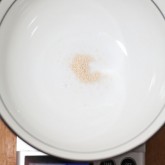
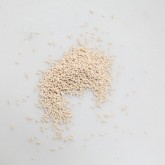
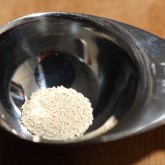
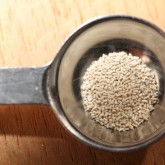

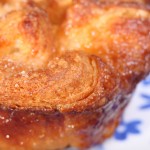
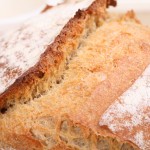
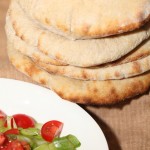
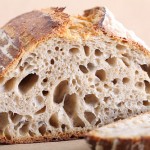
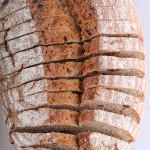
Ruben Colman says
I’ll try your way. . .
Paul says
Hello,
I was born and raised in New Orleans and have been trying (with no luck) to replicate the “po-boy” bread at home. I recently was in Paris and took a baguette class (much fun) with the hopes that I could use what I learned in class and extend it to the po-boy loaf.
I am hoping you are familiar with the New Orleans styled po-boy loaf and might give me a few tips on how I can change a baguette into a po-boy loaf.
Up until my time in Paris I had never heard of a poolish. I had found several recipes on line and none mentioned it. Last night I tried my hand at baguettes (based on my lesson in Paris) and, despite a few foul-ups I came pretty close to a good baguette. Now if I can only make the loaf lighter/airier and the crust a bit lighter and almost cracker like. Then all I would need is some fried shrimp, oysters, roast beef, etc. You get the picture.
I love Texas…but I miss good old N’awlins, especially the food.
Paul
Fredericksburg, TX
Weekend Bakers says
Hi from Holland Paul,
That sounds so very interesting and we are sorry we cannot exactly help you with your quest for a good po-boy loaf, we never made one. We can only offer our own baguette recipe that we love:
www.weekendbakery.com/posts…-baguette/
Maybe if you try and make this with the right type of white bread flour, something good will come of it.
Please let us know if and when you find something that can meet your approval.
Ed & Marieke
Weekend Bakery
Dziadziu says
Hi Marieke and Ed
I don’t know if it’s a appropriate to plug a flour mill but if Paul Googles “Vermont Flour Mill” ( hint: KAF) , their website has a recipe for NOLA style hoagie rolls. I’ve never tried it but it’s a starting point.
Dziadziu
Weekend Bakers says
Thank you for your tip, we are not familiar with it, but hopefully it will be helpful to you Paul.
Tania says
Very helpful precise and easy to understand info for the novice breadmaker
Thanks
Weekend Bakers says
Thank you very much Tania!
Escafon says
Hi,
Thanks for this interesting article!, I am going to buy something to measure tenths of grams!
I hardly ever make bread without preferment but still I have some questions,
1st: I sometimes see recipes with a preferment with yeast, where for the final dough yeast is added another time, what is the reason for this? I would say that a sufficiently ripened preferment allready contains far more yeast than the initial amount, so the biga or poolish would contain enough yeast for the final dough. Still I see extra yeast added in the final dough, there must be a reason for this. (I do not mean hybrid method where yeast is added when there is a preferment with sourdough).
2: What is the difference between a biga and a poolish?
It obviously must make a difference since yeast is a living organism and gluten will react differently to the action of just stirring a poolish or kneading a biga with a hydratatation at about 45%.
What (apart from practical motivations, poolish is less work!) makes you choose between a wetter preferment like a poolish or a drier biga? What are the differences in the final results?
Thanks!
Matthijs.
Weekend Bakers says
Hi Mattijs,
You are really interested in the why and how of bread baking, so we can really recommend investing in a good bread book / ‘bible’ like ‘Bread’ by Jeffrey Hamelman. It explaines things in detail, much better than we ever could.
Extra yeast is added just to speed up the process in general.
Also very general speaking a biga is used to enhance the strength of the dough and a poolish to enhance taste. Working with weaker (Italian) flour would be a reason to use a biga. Next to these two you also have the option of other preferments of course. Which one you choose is a question of your personal taste, flour, other ingredients used and objectives for the recipe. There are many ways to a good loaf.
Escafon says
Thanks! I think It would be a very good christmas present to get that book in my possesion!
Indeed I really like (trying to) understand these kind of processes, biology chemistry etc.
But you have allready anwsered my questions very well, Now i understand allso a bit more about the Ciabatta, in which 5/6 part of the flour is a rather dry biga, which is blown up next day by adding water flour and malt to speed up the yeast by cutting the starch into more “yeastable” sugars. This enourmous amount of biga makes the dough stronger. This allso explains that I get very reasonable results with German supermarket “patent bloem” Lots of biga adds strength to a flour with 11% of protein, which is on the lower side as I understand from your articles.
Anyway, I will get that book!! I really like experimenting with flour water and microorganisms, and a good book will certainly give more direction to my experiments.
Happy baking greatings,
Matthijs.
Weekend Bakers says
Great, lots of happy holiday baking!
MIA says
hello, thank you for this amazing and most importantly poolish starter
I have there questions:
1/what the temperate require for when make a poolish starter ?
2/how to test the poolish is proofed to perfection?how to avoid the poolish is “over-proofed”or“under-proofed”?
3/what’s the difference between a poolish starter and a sponge starter ?
I appreciate if you can answer above questions . thanks
Weekend Bakers says
Hi MIA,
Thank you. It depends on what your purpose is and how fast you want it to develop, but usually it is at room temperature or you slow the process down in the fridge.
You should aim for a bubbly and active poolish that has risen and not yet shrunk back, which you would see by checking the edges of your bowl.
Traditionally poolish usually has 100% hydration while a sponge is a bit stiffer (70 to 80%) but I think people also use the word sponge to just mean ‘preferment’.
Vincent Treacey says
Hi,
Very simple question… I just made a two step white loaf. It came out great but I questioned whether I should have just mixed, or mixed and kneaded the sponge. I kneaded the sponge and left it for 12 hours. the final loaf today has a great taste, texture and crust but just interested if I did it wrong by kneading the sponge.
Weekend Bakers says
Hi Vincent,
You did not do anything wrong, but it is not necessary to knead a sponge, because time will do the work for you and develop the dough!
Harris says
How does the poolish change the amount of yeast in the final dough?
For example in many recipes you put 2% yeast. To make it clearer let’s say you make bread with 1000g flour, 600g water, 20g salt and 20g yeast. If you make a poolish with 30% of the flour you would use: 300g flour, 300g water and 0.9g yeast. In the final dough would you put another 20-0.9 = 19.1g yeast?
Thanks
Weekend Bakers says
Hi Harris,
It totally depends on the recipe, the time you give the poolish, the time temperature and method of the total recipe too. But in general, because 30% of your dough already pre- develops and the yeast in this continues to grow, you would not need to put almost the full amount of yeast of a straight dough bread in your final dough, you would put less in. How much less, also depends on how fast you want to develop the dough. But you can easily cut it to 1/2 or even 1/3 of the initial amount.
Pattty says
Hi , I made my poolish last noght and realized I used the recipe biga when making chiabetta. My poolish receipts called for 2 cups bread flour, 1/2 teaspoon yeast and 3/4 cup water. I used 2 cups of bread flour and 1 cup water, yeast was the same.
I really wanted to make crusty baguettes, could I use my biga and just reduce the bread flour when making my dough to 1 cup? I’m new at this so hope not a dopey question :0
Thanks so much.
Weekend Bakers says
Hi Patty,
It is a bit confusing for us what you did exactly. You say your poolish recipe was 2 cups flour and 3/4 water, but a poolish has equal amounts water and flour. Is it the biga you mean?
Just keep in mind that the ratio of the flour and water (and other ingredients) should be the same (think in percentages) and you should be alright. Take a look at this article that might come in handy in the future: www.weekendbakery.com/posts…mystified/
Happy baking!
Karen says
What can cause the polish to die.
Weekend Bakers says
Hi Karen,
We can think of a few causes, for instance using water that contains too much chlorine or the mixture getting too warm, leaving it in the sun for example (yeast dies at temperatures of around 40 C). It could also be the case the yeast you used never became active because it was past its date for example.
Joe Wisinski says
Dear Ed and Marieke,
I have a recipe that requires a 12 hour rye sourdough levain and a 12 hour wheat preferment using part of the levain ( no yeast in this recipe) . I’m not a fan of sourdough or three day recipes.
As long as I keep the total flour mass and water mass consistent with the recipe, I’d like to make a wheat poolish and a rye biga using yeast and add 1.5% yeast to final recipe. The preferments would total 35% of the total flour and there is also semolina in the recipe. It sounds too complicated. What are your thoughts? It’s difficult to make inedible bread although I have tried in the past! Thank you so much.
Dziadziu
Weekend Bakers says
Hi Joe,
We do not know this recipe, but it is always possible to use a yeast based preferment instead of the sourdough levain. We do not know why you want to use this recipe or what the attraction is of this one if you are not a fan of sourdough or long and complicated recipes, but you are right as long as you keep it consistent it should work out OK 🙂
Good luck with it!
Dziadziu says
Hi Ed and Marieke,
Aside from loving crusty, flavorful bread, here in the US our ethnic roots fade over the generations (as do the recipes… Guilty) . My sole granddaughter is Polish/Portugese/Norwegian/French etc. The bread recipe is Portugese. I try to remind her of all her diverse roots……Portugese tortas, Polish pierogies, Norwegian krumkakkes, (your) French croissants. I love your blog . I’m new to baking…less than a year and need all the help I can get. Thank you for your comments and the education you have given me.
Dziadziu
Weekend Bakers says
Hi Dziadziu,
Thank you for sharing and kind words. Such wonderful roots, especially in relation to baking. Love them all, the things you mention! Hope you will be inspired and will bake for a long time and share it with your family and granddaughter.
Greetings from Holland, / Groetjes uit Nederland
Marieke & Ed
Dziadziu says
Hi Marieke and Ed
Greetings from the US! I made that “complicated ” bread today. I adapted a recipe for Portugese sourdough Alentejo bread ( with your help) and made the bread with a rye yeasted biga and a bread flour yeasted poolish. It took 18 hours instead of 72 and it was just what I was looking for. But………it has raised another question. The crust was crackly when it came out of the oven but became like leather ( tasty leather) as it cooled. All my breads do this. I realize the moisture must equalize (physics 101) but is there a trick to obtaining a crackly , crisp crust on a cool baguette/batard? I use steam. I’ve dusted the loaves with wheat flour, rice flour and semolina with the same results. I’ve resorted to reheating the loaves before serving them.Thanks for all your help. I’ve been baking almost a year.
Dziadziu
Weekend Bakers says
Hi Dziadziu,
Sounds good. About the crust and baking. First you need to know that the bread is properly cooked, so at the right temperature and for the right amount of time. Check out our tips on oven use:
www.weekendbakery.com/posts…your-oven/
and about working with high hydration dough:
www.weekendbakery.com/posts…ion-dough/
where you will find this tip that is essential:
A guideline to check if your high hydration loaf is done, is to measure the core temperature with a digital probe thermometer. For wet dough, like ciabatta, the core bread baking temperature should be around 96C/ 205F (The ideal average bread core temperature should read 93.3C / 200F). The reason being getting rid of the excess moisture still present in the dough. The excess moisture in the core would otherwise soften the crust while cooling, and with a too low core temperature, the crumb will not get the chance to fully stabilize.
Still, there is a reason why baguettes are baked and sold fresh all day in France, the crust still softens within hours and the quick reheating method you use is the best way of getting your crustiness back.
gwen says
Thanks! I’ve baked bread for many years and am pretty good at focaccia (which is easy I know) BUT I did not know about biga. 😀
Weekend Bakers says
Hi Gwen,
Always lots to learn and make your own in baking, we will never stop learning I think and in the meantime we always eat pretty great bread (and focaccia 🙂
Guy says
Dear Ed & Marieke,
I have been baking almost all of your sourdough breads in the last few months and I would like to thank you for the great recipes! I’m especially fond of the whole wheat levain loaf, 70% rye bread with raisins, and the pain rustique.
After all this bread baking I have two preferment-related questions that I would like to ask here:
From the breads on your website I see that the amounts of sourdough differ per bread recipe, e.g. 10g of sourdough per 225g (4,44%) of flour for the pain rustique, 36g per 180g (20%) of flour for the sourdough mini boules, 15g per 65g (23%) of flour for the whole wheat levain loaf, and 15g per 115g (13%) of flour for sourdough pain naturel.
Based on these quantities I experimented lately with a poolish consisting of 800g of flour (50/50 whole rye and bread flour), 800g water, and 160g of sourdough (20% as in sourdough mini boules), and left it to ferment for 12 hours at room temperature. However, when I used it the following day in the final build (containing an additional 1200g of bread flour, 600g of water, and 30g of salt to yield 4 loaves) the dough’s gluten structure was very weak and there was virtually no oven spring. I think the reason for this is that I used too much sourdough culture.
Therefore, I would very much like to understand the factors that influence how much of the sourdough culture is added to the preferment, assuming the dough is fermented at 24 degrees Celsius with a bulk fermentation for 2,5 hours, with stretch and folds at 50 min intervals, and is then proofed for 2,5 hours.
Also, if you want to make a loaf that partly consists of whole wheat flour (let’s say 30%), does it make a difference whether you incorporate all of the whole wheat into the (sourdough-based) preferment or into the final build (assuming you do an autolyse of 30 minutes to hydrate the bran)?
Alvast heel erg bedankt!
Groetjes,
Guy
Weekend Bakers says
Hello Guy,
To better answer your question can you maybe tell us what the poolish looked like after the 12 hours of fermenting, just before you added it to the final dough?
To answer your second question: We usually put it in the preferment so it can soak up the moisture and especially because of the ‘enzymatic activity’ of the whole wheat. Which means the ‘amylase process’ in the whole wheat helps to give your loaf a better crust and taste.
Hector says
Where 100 come from ?
200/100 x0.01
Weekend Bakers says
Hi Hector,
You divide by 100 to get to 1% of 200 grams and then you multiply by 0.1% to get your result. You want to get 1/1000 part of 200.
Fadel Burshan says
Thank you for your valuable information. Your calculations are really helpful.
Weekend Bakers says
Thank you Fadel, glad they are useful.
Esther says
Hi there ,
What is meant by “poolish is one known technique to increase a dough’s extensibility.”? This article is great and I just want to fully understand it.
Many thanks 😊
Weekend Bakers says
Hi Esther,
With extensibility we mean the stretching property of the dough. Dough
with good extensibility is easy to stretch and this is important when it comes to shaping your loaf.
Happy baking and stretching 🙂
Robin @ A Life In The Wild says
Thank you for the photo of yeast in the spoon. My scale isn’t precise enough to measure one loaf’s worth of yeast so I’ve been guesstimating, and I haven’t been using enough. I’m eager to give it another try soon!
Weekend Bakers says
Hi Robin,
Glad it helped. The amounts are indeed tiny!
Brenda Lim says
I prepared some pooling to baguettes. The poolish has peaked and collapsed. Can I still use the poolish as it is?
Frank Barrie says
Appreciate your succinct & clear description of poolish doughs! AND
we’ve linked to that page on your website in our latest post, a dining review of Pizza Monday at Ken’s Artisan Bakery in Portland:
knowwhereyourfoodcomesfrom.com/2016/…land-orego
Cheers! Frank
Tony says
Thank you for an excellent commentary on Bigas / Poolish doughs.
Looking forward to use your suggestions.
Weekend Bakers says
Glad you find it useful Tony!
Mike says
I just discovered your site here in the States (Ohio). You have a great layout and I love the pictures. In addition to flour, water and leavening I add some nutritional yeast to my poolish for added flavor while fermenting. I just finished reading your Croissant article and I hope to make them soon.
Weekend Bakers says
Hi Mike,
Thank you.
We do not have any experience with nutritional yeast and have not yet encountered other bakers that use it, but heard it is popular with people on a vegan diet.
Let us know about your croissant baking results with our recipe.
Happy baking,
Ed & Marieke
Robin says
Hi weekend baker! I’m making a large batch of baugettes that call for a poolish and leaven. Both the poolish and leaven will sit out in room temp for 16 hours prior to baking. The poolish recipe calls for 2000 g flour and 2000 g water. Because this is such a large amount of poolish and because it will sit out for 16 hours in room temp, what percentage of yeast should I use without collapsing the poolish? Also regarding my leaven, what percentage of starter do you recommend that I use to make my leaven? Thank you for your help.
Weekend Bakers says
Hi Robin,
You should stick to the same percentage as with a smaller amount. We cannot really answer your second question without knowing the recipe, as a rule and indication we use about 10 grams per loaf of bread.
Good luck with your batch of baguettes.
marion says
Thank’s for sharing. If I bake with a biga or a poolish, wath % of yeast should I add for the final dough?
Is there a formula?
Weekend Bakers says
Hi Marion,
It depends on how long you want the final dough to proof. The more you add the faster the bulk fermentation will go.
Daphne says
Hi,
Can I freeze my long fermentation dough and at what stage.
My recipe I use is 700g flour to 600ml of water using 9g easy blend dried yeast leave overnight* and then add a further 166ml mix of milk/water with 366g of flour, salt and small amount sugar. Reason for wanting to freeze – I sell at a small local market and want to cut down on ‘manic’ baking the day/night before the market.
* I did have to leave the last lot of sponge for 48hrs in a cool room. thought it would be no good but carried on and finished it – it kneaded better (Richard Bertinet method) and made a superb loaf.
Weekend Bakers says
Hi Daphne,
We cannot give you the right answer to your question from our own experience, we never freeze dough. The freezing is usually done after the first rise, then shaped and frozen. If it is practical and time saving for your schedule, also with thawing, we do not know . The thing we would do is just to go for it and test it with a small batch of dough and make changes if needed. Experimenting often leads to excellent results.
Good luck with it!
Dziadziu says
From my very limited experience you can freeze dough but success depends on freezer temperature and length of freezing and dough type. A dough may survive 20F but not-20F. It may survive a few weeks but not six months. A sweet enriched dough may survive better than a very wet baguette dough. I have had success and failure on the few occasions I’ve tried to freeze dough. My observations are tentative because of my limited experience.
Weekend Bakers says
Thank you for adding your experience Dziadziu!
Mike says
How long would the poolish take in a kitchen that sits around 16c overnight in the winter?
Mike says
Also, do I still need to add more yeast to the recipe when using a poolish?
Weekend Bakers says
Hello Mike,
16C is quite cool and it slows down the activity of the yeast considerably as you can also see in the graph in this posting: www.weekendbakery.com/posts…mperature/
We would advice to find a warmer spot in your house if possible or to increase the amount of yeast in the poolish.
And yes, usually when using a poolish there is also yeast added to the final dough.
Klein says
Mike,
While the poolish will take somewhat longer to mature at 16c what you lose in timeliness you will gain in flavor. The longer the preferment takes to mature the more time the yeast have to create the flavor profile.
As to how much yeast you need to add as part of the final mixture will depend on your bread recipe. It can go from zero to 1/4 of the original recipe.
Wendy Yap says
Can the balance of the sponge dough or poolish be reused for another baking and if yes how do I maintain it. Do i keep it in the fridge?
Thanks
Weekend Bakers says
Hello Wendy,
Normally their is no balance left, you make the right amount for the recipe and use it all. But in case you have something left we would make another small bake with it, some rolls for example or flatbread. You should not confuse a poolish with a sourdough culture. A sourdough culture is something you maintain, a poolish is something you make and use.
Hope this helps.
Beau says
What temperature should the water be for the poolish and how long should I leave the poolish out before refrigeration
Weekend Bakers says
Hello Beau,
Our tap water is around 15 C / 60 F and this is the water we use for the poolish. We would suggest not refrigerating the poolish. You should leave it at room temperature (which is around 20 C / 68 F) and use the times and quantities indicated above (lesser amounts for when it is warm and slightly bigger for when it is warmer). We find we get the perfect poolish, for us, when we use the 12 hour / overnight version, so if that would be possible we would suggest to give this a try too, next to the 24 hour version, and compare the two.
Good luck with it and happy Holiday baking!
Dan Field says
if my preferment uses only instant yeast, is there any flavor advantage to feeding it for more than one day before using in a recipe? does it get better over time?
Weekend Bakers says
A poolish or a biga is not something you feed like a sourdough culture. You make it, wait a while to let it develop and then use it. Otherwise you would be starting a sourdough culture based on commercial yeast.
Klein says
There is no advantage to doing that. Once a preferment is pass its “expiration date”. (The preferment collapses) it is essentially useless. You can try to create a sourdough starter from it but the process is very different and you lose some of the character you would have if you create a sourdough starter using wild years.
Weekend Bakers says
Thank you for your additions and sharing your excellent knowledge!
Marilyn says
I’m new to rustic style bread making and have failed my rye sourdough starter as it has been very cold here lately. My question is could I possibly use this mixture in place of the starter if I measure the same weight the recipe calls for?
Weekend Bakers says
We would suggest to just use yeast in a small amount like in the schedule above instead of the sourdough culture.
Erin says
So I’m wondering if anyone has left a biga/poolish for so long that it couldn’t be used anymore. I accidentally left one sit, unrefridgerated, for a week! When I decided to do something with it, it was very stringy/elasticy, and it had a fair amount of liquid on the surface (vinegar?). It had also darkened quite a bit, which I assume is because the yeast numbers were so high.
I didn’t want to throw it out, so I decided to feed it some flour and throw it in the fridge. Another few days later, I pull it out (today), and it has now the consistency of a sticky paste. I am wondering if it’s just pure yeast now. And if so, can I just package it in the fridge and use as I would dry yeast? I know that cake (wet) yeast can he purchased for baking; how would this be different?
Thanks!
Weekend Bakers says
Hi Erin,
You do have a point because in essence the yeast manufacturers do sort of the same. However! yeast companies produce yeast in a very clean and controlled environment to keep out any bad bacteria’s.
All the gluten in your flour are now destroyed so if you want to use it you would use it as a sourdough culture in very small amounts and not as a ready made poolish. Second however! you have to trust your eyes and nose the judge if you are not poisoning yourself. Same rules as with a sourdough culture apply here, so it needs to smell nice and look good (no strange colors, fluffy stuff) for you to use it. Our advice: When in doubt do not use it.
Maybe some people can add to this based on experience?!
Good luck with it,
Ed & Marieke
Sara says
I am confused by your numbers above, e.g. 0,23% and 3,1g. I have never seen a comma used like that. Do you mean 0.23% or 23%? 3.1g or something else?
Weekend Bakers says
Hello Sara,
Sorry if this is confusing. We use a comma over here where you would a period. We will adjust it, so there can be no misunderstanding about it.
Thank you and happy baking!
Rob says
Thanks for the explanation. My home made bread missed ‘chewyness’ (just as 95% of all bakery bought bread, nice though it may be, could do with a bit more chewyness in my opinion) but making a dough of 50% poolish definitely does it for me… even straight up white!
Weekend Bakers says
Hi Rob,
You are very right, just tested a supermarket ‘artisan’ style loaf today and although the ingredients are better (less) and they claim to give the dough more time etc, the crumb was more like cake to us. Time and prefermentation make a loaf so much more interesting! So lucky we can afford to use both to our advantage.
Rob says
Yes!
I have another question: when making a 50% whole grain, 50% white bread with a poolish, would it be better to use the whole grain, the white or 50% of both for the poolish? Or wouldn’t it matter all that much?
Of course I’ll experiment a bit, but it looks like you already experimented a lot 🙂 so I’d be happy to get your views on the matter.
Thanks!
Rob
Weekend Bakers says
Hi Rob,
To be honest we do not have a direct answer for you based on much experience. Our general idea is that you should use the most interesting flour to develop in the preferment because there simply is more complex flavour to develop if there is more material in the flour.
We will take it on board to experiment more with it and pay extra attention to compare the results.
Would also love to hear about your own experience with this of course.
Len says
In my Ken Forkish book, he makes a “country harvest” bread that uses 10% whole wheat (also, bran and germ but not included in that 10%).
His poolish consists of only white a.p. flour 1/8t instant yeast and water [u]no w.w.[/u] .
The w.w. (and other stuff) gets added after the 12-14 hour “sit” time.
GIOVANNI PIZZOFERRATO says
COULD YOU PLEASE TELL ME HOW MUCH OF A STARTER OR BIGA I WOULD NEED TO MAKE A LOAF OF ITALIAN BREAD?
Weekend Bakers says
It depends on the recipe and what you want to achieve, but you can start with 30% of the flour weight from your recipe and try and see if you like the result. You can go up to 50% of the total, just experiment with it but choose a good recipe and practice with that.
Klein says
For my Italian loaf I use 50% poolish. I do not use biga for my Italian loaf because the crumb is a little finer than I would like. I tend to like bigger pockets and a bit more bite to my Italian loaf. I use biga for my focaccia which makes a wonderful spongie base for the herbs, cheese and veggies and the earthy flavor brings a wonderful counterbalance.
Raina Steiner says
I want to convert my challah recipe to use poolish. I understand it except for how much yeast do I add to the final dough. The original recipe is 4 cups flour, 1 Tblsp. yeast.
Weekend Bakers says
Hi Raina,
That is no problem. You can start with making a poolish with one cup of flour and if you leave it overnight for 12 to 16 hours a quart of a teaspoon of yeast is enough to get an active poolish to add to your final dough.
Good luck with it!
Douglas says
Correct me if I am wrong doing, my biga seats for 16hrs. Usually when we are ready to leave we make our big ato be used in the morning breads.
100% Flour 1,000kg
85% Water 850kg
10% Yeast 10kg
Are we using the right proportion? For a weight of 2,150 flour?
Klein says
Are you using live or dry yeast?
Robin says
This is a great article! I recently ventured into baking whole grain bread using King Arthur 100% whole wheat flour. I’ve read using a starter may help with oven spring as the recipe I have makes a brick rather than a nice loaf. You mentioned needing to adjust the water content in a recipe when converting it to work with a starter, but I’m not sure how much to adjust. The recipe I’m working from has 46% water/oil. Do you think 65% would be accurate? The starter I made this morning included 50% of the recipe’s total flour with an equal amount of water and 0.25% active dry yeast.
Klein says
Robin,
I know exactly where you’re coming from! A lot of home recipes for whole wheat bread is far too dense. I got two bread books that completely changed my outlook on bread. The first is flour, Salt, Water and the second is Tartine Bread. The biggest difference in both is the narrative by the authors about their philosophy for bread and what they are seeking when they bake. But it all boils down to two simple facts. Time means flavor and hydration means lightness in loaves of bread.
To answer your question about lightness of your whole wheat loaf I use hydration percentage. It was easier for me to visualize that way.m They, and now I, weight all my ingredients and we describe a dough hydration by percentage of water to flour (or dry) ingredients. For example, a dough with 1000g of flour and 500g of water meant the drought has 50% hydration.
Most recipes for whole wheat bread have hydration between 56 – 65% hydration which makes the loaves dense. I much prefer my dough to be around 75% hydration which allows the dough the freedom to expand and creat larger bubbles which, in turn, create lighter bread. One thing I do recommend is to use a mixture first. Go with 50/50 bread flour to wheat flour then raise your percentage of wheat flour until you find the whole wheat loaf you absolutely love. One note of caution. Wheat flour is approximately 15% lighter by volume so be aware of that if you choose to measure your ingredients by volume than weight.